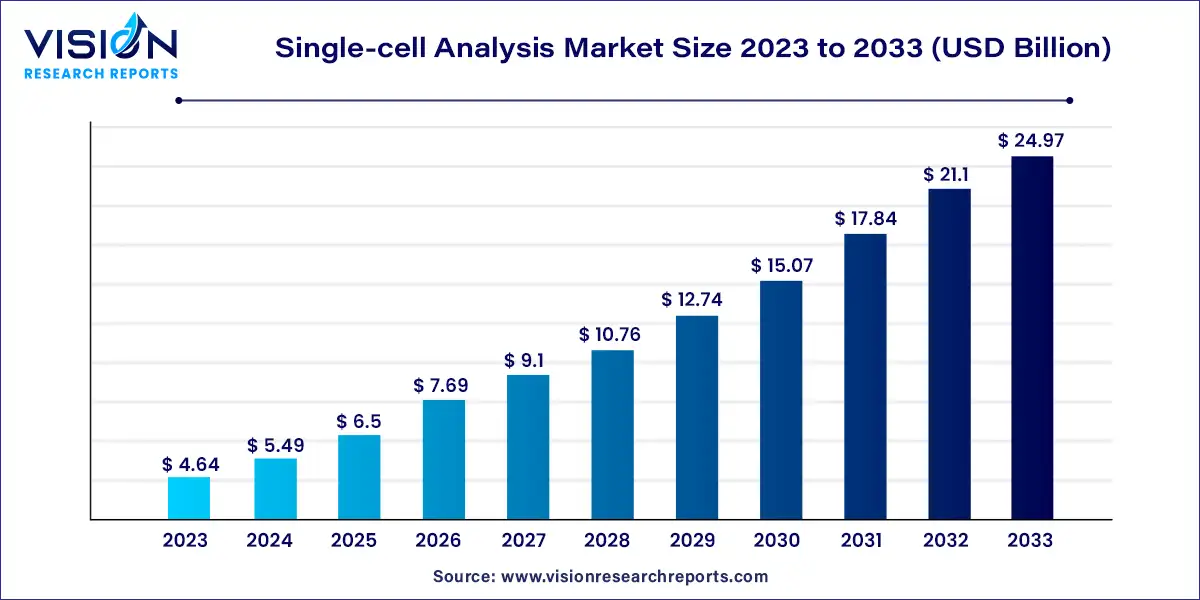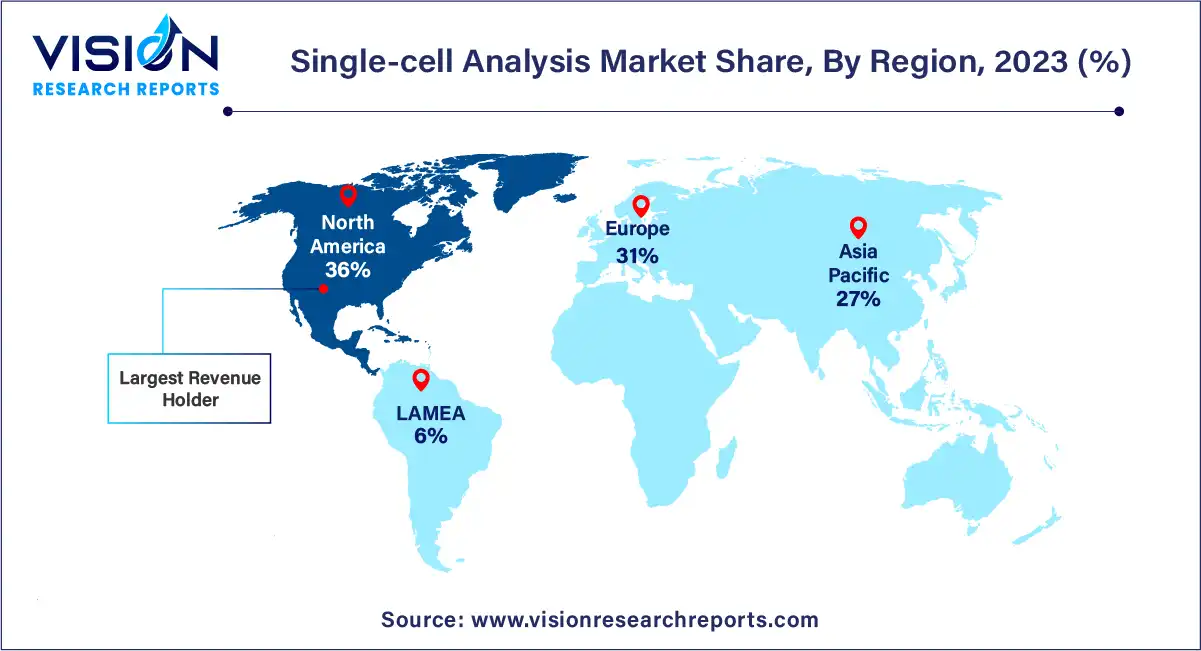The global single-cell analysis market size was estimated at around USD 4.64 billion in 2023 and it is projected to hit around USD 24.97 billion by 2033, growing at a CAGR of 18.33% from 2024 to 2033.

In recent years, single-cell analysis has emerged as a revolutionary technique in the field of biomedical research, offering unprecedented insights into cellular heterogeneity and function. This innovative approach enables the study of individual cells, providing researchers with a deeper understanding of complex biological systems and disease mechanisms. As a result, the single-cell analysis market has witnessed significant growth, driven by advancements in technology, increasing research activities, and rising demand for personalized medicine solutions.
The growth of the single-cell analysis market is driven by various factors contributing to its expansion. Technological advancements play a pivotal role, with continuous innovations enhancing the capabilities of single-cell analysis techniques such as microfluidics, next-generation sequencing, and imaging methods. These advancements enable researchers to delve deeper into cellular heterogeneity and function, attracting increasing interest from academic institutions, biotechnology companies, and pharmaceutical firms. Moreover, the rising demand for personalized medicine solutions has further fueled market growth, as single-cell analysis provides crucial insights into individual cellular profiles essential for developing tailored therapeutic strategies. Additionally, the advantages offered by single-cell analysis over traditional bulk analysis methods, including the detection of rare cell populations and the study of dynamic cellular processes, have led to its widespread adoption across various research fields. As research activities intensify and the need for precise cellular analysis continues to rise, the single-cell analysis market is poised for sustained growth in the foreseeable future.
The consumables segment held a dominant market share of 56% in 2023 and is projected to experience the fastest growth rate of 19.65% during the forecast period. This significant share can be attributed to several factors including the widespread use of isolation products, the extensive adoption of cell sorting beads, frequent purchases of buffers and reagents, and the increasing demand for assay kits. The rise in the prevalence of target diseases coupled with the continuous requirement for consumables essential for scientific assays is driving the growth of this segment.
Revenue generation for the instruments segment is primarily driven by the installation of new instruments, replacement of old ones, and related services. Automated instruments are expected to witness significant growth during the forecast period due to their advanced features and technically sophisticated analytical options.
In 2023, the cancer segment dominated the market, capturing the highest share at 35%. It is projected to maintain its position as the fastest-growing segment, with a CAGR of 19.96% from 2024 to 2033. Single-cell analysis has emerged as a crucial tool for cancer cell diagnosis, enabling the identification of genetic variations, cell proliferation conditions, mutation rates, and cell types with precision.
The proliferation of research activities focused on single-cell genomics and proteomics has led to the widespread adoption of Single-Cell Analysis (SCA) methods in therapeutic and diagnostic applications. Furthermore, the rising demand for stem cell therapies in regenerative and personalized medicine applications is further fueling market growth.
In 2023, the single-cell isolation and library preparation segment held a substantial revenue share of 39%. The diverse range of applications for Single-Cell Analysis (SCA) has led to increased demand for cell isolation and library preparation products, including kits and reagents. Additionally, a significant number of industry players offer various products for single-cell isolation, such as FACS and MACS for heterogeneous cell suspensions, microdissection of fixed tissue samples, flow cytometry, and microfluidics. This variety of offerings in the segment contributes to revenue growth.
The downstream analysis segment is gaining momentum, driven by technological advancements in recent years. It is projected to be the fastest-growing segment, with a growth rate of 21.22% during the forecast period. Technologies like next-generation sequencing for cellular expression analysis, mass spectrometry, and Fluorescence in situ hybridization (FISH) have become crucial tools for SCA. Furthermore, the market is witnessing increased automation of machines and the integration of artificial intelligence for data analysis. Numerous software and computational methods have been developed and are being utilized due to their scalability, flexibility, and high success rates. For instance, as of 2021, there were over 1000 single-cell RNA analysis tools available. This proliferation of database tools reflects the growing interest and accessibility of SCA technologies, thereby driving industry growth in the foreseeable future.
In 2023, academic and research laboratories commanded a significant revenue share of 75%. This dominance is attributed to the widespread adoption of single-cell analysis (SCA) technology within research settings. The substantial number of ongoing scientific projects across various universities utilizing SCA techniques has fueled its adoption. Additionally, the introduction of spatial genomics has accelerated single-cell analysis in research activities, further driving this segment. Furthermore, the development of new tools to overcome research limitations is contributing to market growth. For instance, researchers at Stony Brook University in New York developed a novel biomedical research tool called single-cell cyclic multiplex in situ tagging (CycMIST) technology in June 2023. This technology enables scientists to assess functional proteins in a single cell, thereby making significant contributions to the fields of diagnostics and discovery.
The biotechnology and pharmaceutical companies segment are anticipated to experience significant growth, with a compound annual growth rate (CAGR) of 18.19%. Technological advancements such as the utilization of microfluidics for the development of cell and gene therapies have spurred the adoption of SCA by biotechnology and pharmaceutical companies. Furthermore, the increasing incorporation of multi-omics in drug development research is expected to further propel the market. Many firms have invested in genomics to gain access to various genomics databases. For example, Lifebit, a U.K.-based big data company, announced a partnership with Boehringer Ingelheim in March 2023.
North America emerged as the dominant force in the global single-cell analysis market, capturing a revenue share of 36% in 2023. This supremacy can be credited to several factors, including the presence of multiple government funding programs, heightened awareness regarding personal healthcare and related expenditures, swift adoption of novel analytical tools and techniques, and the availability of well-trained personnel. The United States stands out as a major contributor to North America's industry growth.

The Asia Pacific region is poised to be the fastest-growing region, with a forecasted CAGR of 19.88% during the projection period. In recent years, the burgeoning medical industry, rapid development of healthcare systems, and increasing elderly population have spurred demand for cutting-edge diagnostic tools in the emerging economies of Asia Pacific. Focused efforts and outsourcing initiatives in this region have significantly fueled growth.
By Product
By Application
By Workflow
By End-use
By Region
 Cross-segment Market Size and Analysis for
Mentioned Segments
Cross-segment Market Size and Analysis for
Mentioned Segments
 Additional Company Profiles (Upto 5 With No Cost)
Additional Company Profiles (Upto 5 With No Cost)
 Additional Countries (Apart From Mentioned Countries)
Additional Countries (Apart From Mentioned Countries)
 Country/Region-specific Report
Country/Region-specific Report
 Go To Market Strategy
Go To Market Strategy
 Region Specific Market Dynamics
Region Specific Market Dynamics Region Level Market Share
Region Level Market Share Import Export Analysis
Import Export Analysis Production Analysis
Production Analysis Others
Others